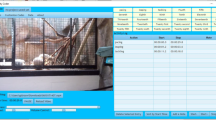Abstract
This study investigated whether brief segments of nonverbal behavior or “thin slices” would be representative of behavior across a longer interaction. It was hypothesized that behavioral slices would correlate with behavior across a full 15-minute interaction. Five commonly investigated nonverbal behaviors were coded: gazing, gestures, nods, smiles, and self-touch. The findings showed moderate to high positive correlations between the thin slices (1-minute slice, total of two 1-minute slices, total of three 1-minute slices) and the full interaction for all five behaviors. In regards to behavioral coding, the thin-slice methodology proposed could save nonverbal researchers considerable time, energy, and money by decreasing resources dedicated to coding behavior in some types of interactions. Such results suggest that thin slices could represent an individual’s behavior across a longer length of time.
Similar content being viewed by others
References
N. Ambady F. J. Bernieri J. A. Richeson (2000) Toward a histology of social behavior: Judgmental accuracy from thin slices of the behavioral stream M. P. Zanna (Eds) Advances in experimental social psychology NumberInSeriesVol. 32 Academic Press San Diego, CA 201–271
N. Ambady D. LaPlante D. Johnson (2001) Thin-slice judgments as a measure of interpersonal sensitivity J. A. Hall F. J. Bernieri (Eds) Interpersonal sensitivity: Theory and measurement Erlbaum Mahwah, NJ 89–101
N. Ambady R. Rosenthal (1992) ArticleTitleThin slices of expressive behavior as predictors of interpersonal consequences: A meta-analysis Psychological Bulletin 111 256–274 Occurrence Handle10.1037/0033-2909.111.2.256 Occurrence HandleA1992HF82100003
N. Ambady R. Rosenthal (1993) ArticleTitleHalf a minute: Predicting teacher evaluations from thin slices of nonverbal behavior and physical attractiveness Journal of Personality and Social Psychology 64 431–441 Occurrence Handle10.1037/0022-3514.64.3.431 Occurrence HandleA1993KR87500011
G. Bente W. C. Donaghy D. Suwelack (1998) ArticleTitleSex differences in body movement and visual attention: An integrated analysis of movement and gaze in mixed-sex dyads Journal of Nonverbal Behavior 22 31–58 Occurrence Handle10.1023/A:1022900525673 Occurrence Handle000072550000002
J. Cohen P. Cohen (1983) Applied multiple regression/correlation analysis for the behavioral sciences EditionNumber2 Erlbaum Hillsdale, NJ
B. M. DePaulo H. S. Friedman (1998) Nonverbal communication D. Gilbert S. T. Fiske (Eds) The handbook of social psychology EditionNumber4 NumberInSeriesVol. 2 McGraw-Hill New York 3–40
J. F. Dovidio K. Kawakami S. L. Gaertner (2002) ArticleTitleImplicit and explicit prejudice and interracial interaction Journal of Personality and Social Psychology 82 62–68 Occurrence Handle10.1037/0022-3514.82.1.62 Occurrence Handle11811635 Occurrence Handle000173253100005
H. A. Elfenbein N. Ambady (2002) ArticleTitleOn the universality and cultural specificity of emotion recognition: A meta-analysis Psychological Bulletin 128 203–235 Occurrence Handle11931516 Occurrence Handle000174471000001
S. D. Gosling O. P. John K. H. Craik R. W. Robins (1998) ArticleTitleDo people know how they behave? Self-reported act frequencies compared with on-line codings by observers Journal of Personality and Social Psychology 74 1337–1349 Occurrence Handle10.1037/0022-3514.74.5.1337 Occurrence Handle9599447 Occurrence Handle000073505800017
J. E. Grahe F. J Bernieri (1999) ArticleTitleThe importance of nonverbal cues in judging rapport Journal of Nonverbal Behavior 23 253–269 Occurrence Handle10.1023/A:1021698725361 Occurrence Handle000084512000001
Hall, J. A., Murphy, N. A., & Carney, D. R. (2005). On the varieties of asymmetrical outcome dependencies: Feelings, motives, behavior, and accuracy in a dyadic interaction. Manuscript submitted for publication
J. A. Harrigan K. T. Taing (1997) ArticleTitleFooled by a smile: Detecting anxiety in others Journal of Nonverbal Behavior 21 203–221 Occurrence Handle10.1023/A:1024921631009 Occurrence HandleA1997YA22400004
Murphy, N. A. (2003). Intelligence in social interaction. Northeastern University, Boston, unpublished doctoral dissertation
N. A. Murphy J. A. Hall C. R. Colvin (2003) ArticleTitleAccurate intelligence assessments in social interactions: Mediators and gender effects Journal of Personality 71 465–493 Occurrence Handle12762423 Occurrence Handle000182705500008
T. L. Newton J. M. Haviland R. J. Contrada (1996) ArticleTitleThe face of repressive coping: Social context and the display of hostile expressions and social smiles Journal of Nonverbal Behavior 20 3–22 Occurrence Handle10.1007/BF02248712 Occurrence HandleA1996TZ54700001
Schmid Mast, M., Murphy, N. A., & Hall, J. A. (in press). A brief review of interpersonal sensitivity: Measuring accuracy in perceiving others. In D. Chadee & J. A. Young (Eds.), Current themes and perspectives in social psychology
J. S. Tucker S. L. Anders (1998) ArticleTitleAdult attachment style and nonverbal closeness in dating couples Journal of Nonverbal Behavior 22 109–124 Occurrence Handle10.1023/A:1022980231204 Occurrence Handle000073782600002
Urbaniak, G. C., & Plous, S. (2003). Research randomizer. Retrieved March 1, 2004, from http://www.randomizer.org
Author information
Authors and Affiliations
Corresponding author
Additional information
Nora A. Murphy is now at the Department of Psychology, Brandeis University, Waltham, MA.
The data was collected at Northeastern University and the research was supported by National Science Foundation grant SBR 97 09032 awarded to Judith A. Hall.
Rights and permissions
About this article
Cite this article
Murphy, N.A. Using Thin Slices for Behavioral Coding. J Nonverbal Behav 29, 235–246 (2005). https://doi.org/10.1007/s10919-005-7722-x
Issue Date:
DOI: https://doi.org/10.1007/s10919-005-7722-x



